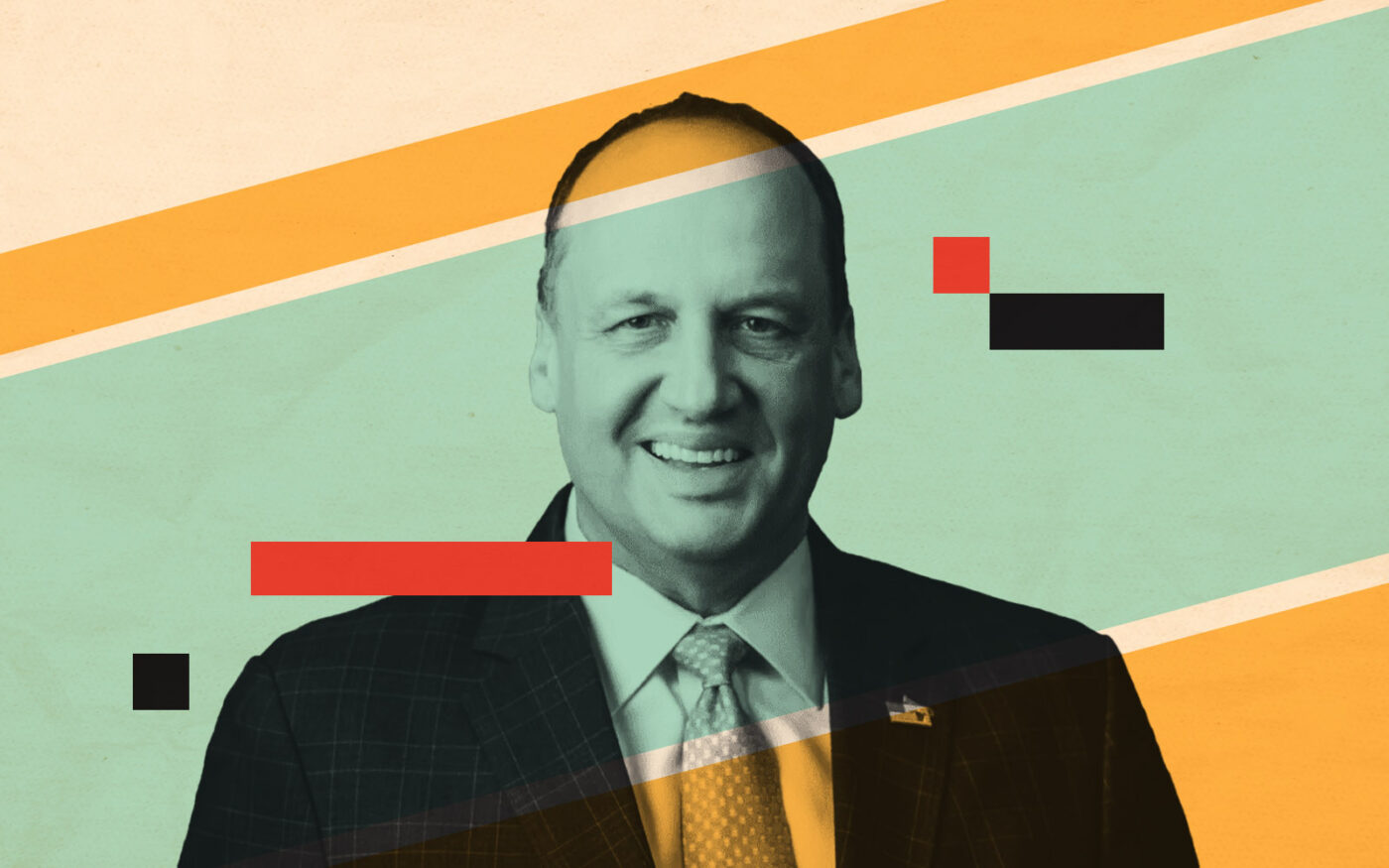Trending
KBS Realty CEO talks about office pain
Marc DeLuca discusses office-resi conversions, multifamily markets and Union Bank Plaza

When Marc DeLuca was named CEO of KBS Realty Advisors in 2022, interest rates were low and insiders were still hopeful workers would go back to the office. SInce then the tides have turned.
“Part of the problem is that nobody knows what a building’s worth right now,” DeLuca said about the office market. “The lack of trades is something unprecedented.”
Since DeLuca has stepped in to lead the firm, KBS has mostly moved away from its office roots in Southern California, investing in markets such as Charlotte, Dallas and Chicago. Last month, the firm cashed out of one of two buildings it has left in Southern California — the 52-story Union Bank Plaza in Downtown L.A.
For DeLuca, the decision is simple: West Coast markets like Los Angeles, San Francisco and Portland are seeing high office vacancy rates and a lackluster desire from employees to get back to the office.
The Real Deal chatted with DeLuca over Zoom about his firm’s shift towards the East Coast and Midwest, the Union Bank Plaza deal and office-to-residential conversions.
What’s your thinking about the office market?
There are some markets we believe are in trouble and will continue to be and will take many years to recover — like Portland. We had a big presence there. We still hold some today, unfortunately. But that market became … just the civil unrest. Everything going on in downtown Portland is a shame. It’s just a completely downward spiral. Not too dissimilar from what we’re seeing in places like Downtown L.A., San Francisco, parts of New York, parts of Chicago, parts of Minneapolis.
But what’s important to understand is that even within those markets — we have a building in downtown Chicago. Accenture came in and said, “We want to put our U.S. headquarters here.” We signed a big long-term lease with them. At the beginning of 2022, that building was like 79 percent leased. It’s 94.5 percent leased right now. People are floored by that. Number one, they’re concerned about Chicago. But what they don’t understand is there’s these little pockets of buildings, not too dissimilar from any asset class that outshines and performs better in certain times, for certain reasons.
That’s the flight to quality argument. So there are certain amenities that boost an office building in a great location, but you couldn’t do that to every building in Downtown L.A.?
That’s right. You know, you covered it, we sold Union Bank Plaza. We think that was a huge success, yet, was it less than what we wanted? Of course it was. But given the time in the market — we just had Brookfield give back two buildings in downtown L.A., right? A decade up, we sold it and I wish it was a lot more money to us, to the shareholders. But it was our last asset there and we needed to sell it. The time horizon was ending in our [REIT’s] plan of liquidation. And we found a buyer [Joel Schreiber] who was willing to perform and fortunately, we got them in bed early with a deposit that was at risk.
We were successfully able to return that $120 some odd million to our investors, as opposed to just giving back a building and walking away from it. But no matter what we would have done to that building right now, there’s just not a lot of tenants looking for office space in downtown L.A.
And you saw that as a struggle before you even sold the building?
That’s right. What happened was Union Bank was being acquired [by U.S. Bancorp in 2022]. We knew at that point in time that there was going to be some vacancy, and Union Bank would be giving up that space ultimately. So we said, “We just need to get out of this. Return investors money. So let’s go ahead and move.” We did some amenities there. And it got us back to some of the space leased, but with that big Union Bank, uncertainty sitting out there, we had to move and sell the thing.
Would you consider buying any other asset in Downtown L.A. right now?
Honestly, no.
Are you looking at office-to-residential conversions anywhere?
The struggle in doing that is you have to have the ability to have a completely vacant building. But before that even happens, you’ve got to make sure the property you have is cohesive to doing a project like that. The core layout of the stairwells all have to be fairly well laid out to do that.
We had a three building project out in Virginia, a defense contractor that was in there. They vacated and we started the entitlement process. We were going to knock down the buildings and do what people call a Texas donut — where you build the parking and build multifamily apartments around that, putting in 102 townhome lots. We got to the whole entitlement process — what we thought would take three years, we got it done in 18 months. Then a multifamily developer came along and offered us a bunch of money. He went ahead and proceeded doing that project.
So we’ve never actually gone all the way through with one. But we’ve gotten pretty close to pulling the trigger. I do think you will have better opportunities in markets like — for example,
Union Bank Plaza. If Union Bank ever left that building empty, I think Joel [Schreiber] will kill it as a multifamily conversion.
How are you getting financing or refinancing for projects?
I said today to guys from JLL, I was speaking with a bunch of bankers, a couple from Wells Fargo, some from JP Morgan, another person from U.S. Bank. We’re sitting here talking about different miseries. And I joked, “Well, I guess none of you have ever gotten fired for doing an office loan in the last eight months, have you?” And they all started laughing. Then one said, “One of the things that we’re really looking at is, we don’t want to take on other people’s problems.” So that was a little discouraging.
There has been a lot of attractiveness to CMBS, because you can price it at various tranches to still make it attractive for investors to buy in, but also have a blended rate that could still be attractive to us as a borrower. But, the rates compared to where we were, have gone up double. I think the good news with us is we have very little debt rolling, because we have extensions built into all of them. Now, extensions do face another level of scrutiny. But part of the problem we have is that nobody knows what a building’s worth right now. The lack of trades is something unprecedented.
Do you think banks are going to be hesitant to hold delinquent properties on their books?
Yes, I do. Unfortunately, we’ve had this great credit cycle, where credit was so free flowing. And banks really never paid huge attention to the dynamics.The driving forces behind a lot of these markets is diving into the actual where that building sits within its asset class. I think that’s got to be the first step — they got to look at that and say, “OK, can I get made whole on this building? Or do I just need to go sell to somebody else and take a discount?”
How has this shifted your investment perspective? Are you moving towards other asset classes like multifamily or industrial?
My fear is the yields on those classes were so dramatically low, and you were driven by such a low interest rate environment. From an industrial standpoint, I don’t know how that can come back. It also relied heavily on the Amazons and Walmarts of the world. I have a little bit of a pause on the industrial side.
On the multifamily side, I feel a little bit more comfortable and confident. We have some land that we’re looking at potentially doing some stuff with. I think you will continue to see an increase in multifamily rental rates. I’m a little concerned about the high, high-end multifamily because those rental rates have gone to the ceiling. Something I’ve never seen before. There’s a place that I stare out my window at right now called the Earl apartments [in Arlington, Virginia.] They were asking for their penthouse, a two-bedroom, two-bath — $6,900 or $7,100 a month. It’s crazy. I’m cautiously optimistic on both.




